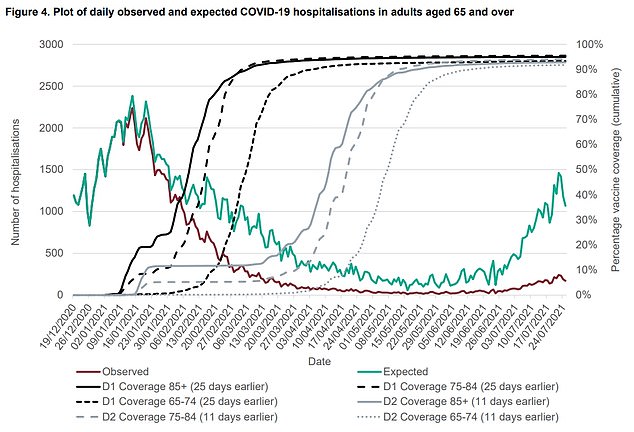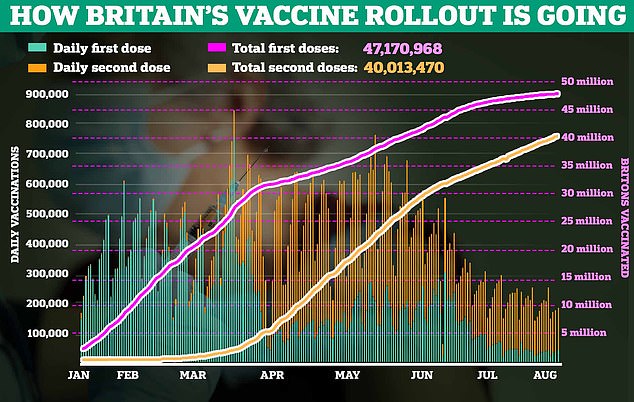Public Health England was today accused of being ‘away with the fairies’ for claiming that Covid vaccines have prevented 23.4million infections.
The Government-run agency, which will be axed within a matter of weeks, yesterday released ‘remarkable’ updated estimates about how well the jabs have worked.
As well as drastically curbing the spread of the coronavirus, the PHE data suggested vaccines have saved more than 84,000 lives and prevented almost 67,000 hospital admissions.
But experts today questioned the maths behind the estimate.
Professor David Livermore, a microbiologist at the University of East Anglia, said the jabs have undoubtedly thwarted the spread of Covid and saved tens of thousands of lives.
But he told MailOnline it ‘cannot possibly be correct’ that more than 20million cases were stopped.
Vaccines are thought to cut infections by around 60 per cent, so in order for them to have prevented 23.4million, the UK would have had to have seen approximately 17m cases among unvaccinated people since the start of the rollout, he explained.
There have only been 3.8million confirmed cases among the entire population since the start of the year — and most have been unvaccinated during that time.
Professor Livermore said: ‘The 85,000 deaths prevented is plausible — it’d be a fifth of the care home population, who are the most vulnerable.
‘But 23.4million infections prevented cannot possibly be correct. I find myself a little shocked that (the figure) isn’t getting a sanity check anywhere.
‘It’s away with the fairies and whatever mathematical model has been used to project these numbers needs a serious review.’
PHE said its model is based on a worst-case scenario with no vaccines or lockdowns to protect the population. Sources at the health body said it is ‘impossible to predict’ how the pandemic would have played out without jabs in reality.

Graph shows: The number of hospitalisations in over-65s (brown line) plotted against the number of expected admissions without the vaccine programme (green line). The dotted lines show vaccine coverage in people aged 85 and above, 75 to 84 and 65 to 74 for first (D1) and second (D2) doses

Professor David Livermore, a microbiologist at the University of East Anglia, told MailOnline it ‘cannot possibly be correct’ that more than 20million Covid cases have been stopped by vaccines

Why IS Public Health England’s modelling being questioned?
PHE yesterday claimed vaccines had prevented 23.4million people being infected in England.
Vaccines are estimated to only prevent 50 to 60 per cent of infections, with their main role to prevent serious disease and death from the virus.
In order for 23.4million to be prevented, there would have to have been 17million vaccinated people infected by that ratio.
This means the model predicts without vaccines, there would have been just over 40million Covid cases in total.
In reality, Britain only recorded 3.8million confirmed cases among the entire population since the start of the year.
But the actual case numbers, published by the Government every day, are only based on positive tests. Not everyone who gets Covid will develop symptoms and ask for a swab.
Advertisement
Professor Livermore claimed in order for the numbers to add up, there would have to have been 40million Covid infections if not for the vaccine in PHE’s model.
He said: ‘That’s 60 per cent of a UK population that’d already experienced the first and — substantially — second waves, generating significant natural immunity.
‘Again, utterly implausible.’
But the actual case numbers, published by the Government every day, are only based on positive tests. Not everyone who gets Covid will develop symptoms and ask for a swab.
PHE said its real-time surveillance model — developed with the University of Cambridge — compares how the pandemic played out with vaccines to a counterfactual scenario where no vaccines had occurred.
But it also assumes the Government did not introduce a lockdown in January, meaning cases would have continued to soar after the second peak.
Sources admitted in reality, it is likely lockdown would have been extended and restrictions not eased on July 19 if not for the vaccine programme, which would have reduced the number of cases than what is predicted by the model.
The main purpose of vaccines is to prevent severe illness and death from Covid.
Experts have always been open that jabs are not 100 per cent effective at stopping mild infection. It is, for this reason, many believe herd immunity is impossible.
But PHE yesterday boasted it figures prove just how well the vaccines work at reducing cases.
Dr Mary Ramsay, PHE’s head of immunisations, said: ‘These figures show the vaccine programme’s remarkable impact on saving lives and reducing the spread of the virus.
‘As cases have increased, the true scale of protection from the vaccine programme has become clear. Everyone who has come forward for the vaccine has played a part in this vital effort.
‘It’s important people under 30 continue to take up the offer of the vaccine. Infection rates are highest in this age group and Covid can be serious for some.’
It came as teenagers as young as 17 were invited to book their first vaccine appointment if they are within three months of their 18th birthday.
In line with Joint Committee of Vaccination and Immunisation (JCVI) guidance issued last week, the NHS is already vaccinating people who are 16 and 17 with a single dose of the jab at GP and walk-in sites, and more than 16,000 in this age received theirs last weekend.
Vaccination sites across the country are working hard to complete the rollout with more than 300 sites already offering the jab to 16- and 17-year-olds including GP teams who began vaccinating eligible teens last week.
Children aged 12 to 15 who are clinically vulnerable or who live with adults who are at increased risk of serious illness from the virus are also being contacted by the NHS and invited for their vaccine.
Source link : https://www.dailymail.co.uk/news/article-9891243/Fury-Public-Health-Englands-claim-vaccines-prevented-23-4million-Covid-cases.html











